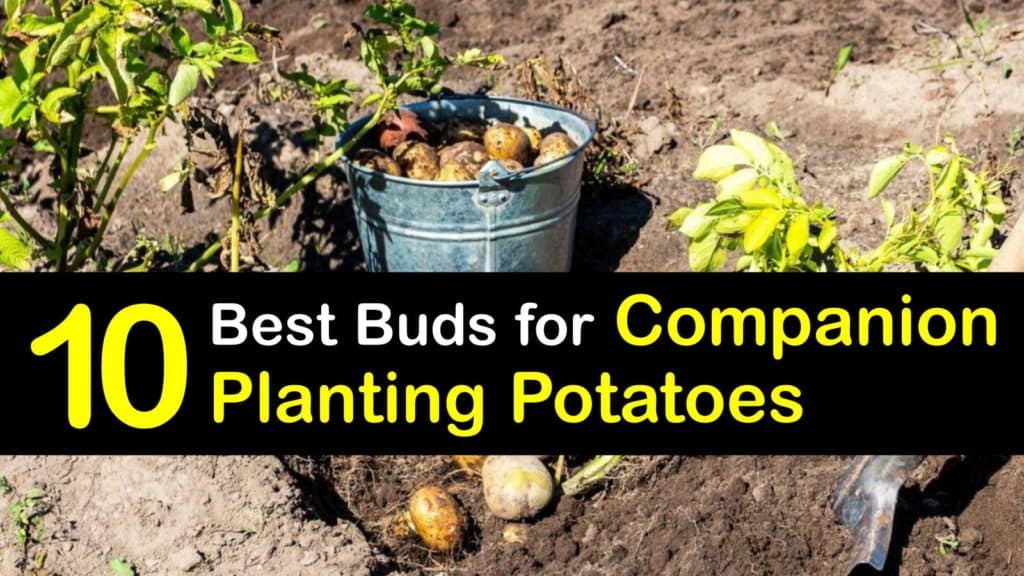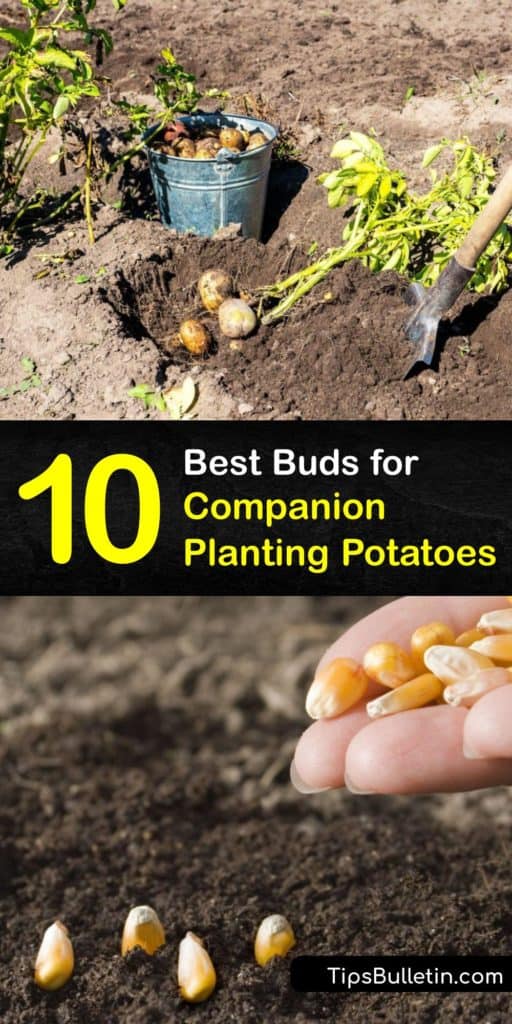Gardening is an art form. It takes skill and valuable information to understand which plants are safe when placed next to one another and which ones will bring the other down. Companion planting potatoes is an especially tricky task.
All different kinds of potatoes grow well close to a wide variety of fruits, veggies, and aromatic herbs. On the other hand, some companions do more harm than good.
Understanding potato companion planting helps you develop a plan so that every single plant in your home garden thrives. With that said, knowing what to plant next to potatoes might change depending on what your demands are.

Companion Planting Basics
Some plants are better at getting rid of insects, and others are beneficial simply based on how deep the root crops grow. Thankfully, you’ve stumbled upon this article that goes in-depth about what to plant with potatoes based on the results you’re looking for.
In general, companion plants are used to plant certain species close together to enhance one another in some way. There are a lot of good reasons why you might seek out the best companion when planting potatoes.
Some companion plants won’t compete for growth because they complement one another. For example, growing deep-rooted vegetables next to shallow-rooted vegetables offers efficiency and maximizes garden bed space.
Good companion plants have similar growth requirements, including water, sunlight, and fertilizer. Others act as pest deterrents to potato plants and keep their predators at bay. Many potato growing problems and diseases can be averted by companion planting.
Some plants also use different nutrients, which is an excellent way to ensure your soil is doing a good job for as many crops as possible. Others put the nutrients back into the soil that the other one is looking for.
If all of that weren’t enough, it is even said that some plants enhance the flavor of other plants in the vegetable garden when they are close to one another.
It seems easy, but companion planting potatoes is often more complicated than people expect. With every benefit, there may be another drawback that you have to deal with in the future.

The gardener’s goal is to play a role and devote themselves to sustaining healthy crops in a natural or organic way.
What to Plant Next to Potatoes
Companion planting for potatoes takes time and effort. After hours of research, take everything you learn, try it on your garden, and hope everything works out.
We have completed all the tedious work for you and created a potato companion planting guide, so everything is all in one place.
Whether you regrow potatoes in the kitchen or direct sow them in the garden, here’s what you need to know to take advantage of companion planting with potatoes.
Companion Planting Potatoes with Brassicas
Brassicas belong to the cabbage family, and it includes cauliflower, cabbage, collard greens, kohlrabi, chard, and kale. All of these plants have a shallow root system compared to potatoes. Tubers make a great companion plant for broccoli and other cole crops.
The shallow roots don’t compete for space or the nutrients that the potatoes require, whether you are growing potato plants from eyes or have seed potatoes. This is an excellent way to maximize as much space as possible in your garden.
Alyssum and Potatoes
Alyssum is a pretty groundcover flower that gives a garden a subtle pop of color. The flowers serve as a natural mulch substitute and attract a lot of beneficial insects to the beds.
These essential pollinators ensure all the plants stay healthy while the plants retain moisture in the soil and deter weeds from sucking up too many nutrients.
Potato Companion Planting with Chives
Chives are a crucial member of the allium family, along with onions, leeks, and artichokes. We know what you’re thinking – is planting potatoes and onions together safe?
Onions, carrots, asparagus, and fennel are all plants that you want to avoid when potato companion planting because they stunt the growth of the potatoes and create tubers. If chives are part of the onion family, why are they on this list?
Chives are related to onions, but they are not the same. They are shallow-rooted herbs and don’t use the same space as the potatoes. They attract beneficial insects to your beds and are a delicious herb to put on a baked or roasted potato.
Similarly, leeks are another plant to plant with potatoes despite being in the allium family. They have shallow roots and taste delicious when paired with other potato dishes like scalloped potatoes.
Warm your oven to 350°F and spray a baking dish with cooking spray. Put a medium saucepan on a hot burner and add the butter until it melts. Add the leeks and cook them for two minutes before stirring in the thyme and garlic.
Stir in the cream, milk, salt, and pepper, and bring everything to a boil. Lower the heat and simmer it for five minutes to thicken.
Add the potatoes to the pan and stir them, so everything is evenly coated in the sauce. Transfer the mix to the baking dish and bake the potatoes and leeks for one hour until bubbly and brown on top.
Herbs for Planting Near Potatoes
Aromatic herbs like chamomile, tansy, parsley, thyme, oregano, basil, summer savory, yarrow, and coriander or cilantro, are all excellent options as companion plants.
The fresh smells attract bugs like hoverflies, ladybugs, parasitoid wasps, and lacewings, which prey on the more harmful pests that target potatoes, like the Colorado potato beetles and aphids.
Potato beetles lay their eggs on potato leaves. After they hatch, they climb under the soil and feast on the roots until they mature. Eventually, the bugs arise from the ground and search for a mate, only to repeat the process again and again.
Horseradish and Potatoes
Horseradish has a robust flavor, but a lot of people love it. Better yet, it is a good companion plant for potatoes. Horseradish repels flea beetles and takes care of the issue if you are infested by potato bugs.
They also improve a potato plant’s resistance to disease. It’s worth adding a few of these plants and seeing how they benefit the health of your potato plants this growing season.
If the problem is severe enough, it may be best to make a homemade potato bug spray from natural ingredients you probably already have at home.
Beans and Legumes
Trying to develop relevant ideas for what to plant next to potatoes is a challenge, but that doesn’t mean the final result won’t be delicious. Beans and legumes make fine companions to potatoes.
Pole beans, snap peas, green beans, and bush beans are only some plants that work well next to potatoes. They provide the soil with a healthy dose of nitrogen, and in return, the potatoes deter Mexican bean beetles that attack the legumes.
What Flowers to Plant with Potatoes?
If you don’t feel like adding more veggies to the garden, flowers emit a lovely scent and add bold pops of color to the exterior of your home. Marigolds, nasturtiums, petunias, borage, catnip, calendula, and hyssop are a handful of options you might consider.
Marigolds are the most popular companion plants because they repel a wide variety of pests for numerous species. Nasturtiums work in a different way. These flowers actually attract aphids and potato beetles.
It seems counterintuitive when you first hear it, but it is highly strategic if you plant them further away than the other companion plants.
While the ones closer to the potatoes are repelling the bugs, the nasturtiums attract all the pests to their designated area instead.
Plants to Avoid Growing Next to Potatoes
As discussed before, not all plants work well together. They compete for space and resources, and in the end, one of them will win over the other.
As a general rule, never plant anything in the nightshade family together. Nightshades include potatoes, tomatoes, and eggplant.
Fruit Trees
Fruit trees and other vegetable plants are not typically grown next to one another, but crazier things have happened. Apple, cherry, and peach trees attract blight.
This disease wipes your potato crop out faster than any other disease, so if you have any fruit trees in your yard, try to keep them as far away from your potatoes as possible.
Other Root Vegetables
Because they often use the same nutrients, potatoes don’t enjoy being buddies with other root vegetables.
These types of plants include carrots, turnips, parsnips, and radishes. Growing these plants together inhibits their growth and leaves you with a less-than-ideal harvest.
Zucchini
A lot of home gardeners view both potatoes and zucchini and staples in their beds. It is okay to plant them at a safe distance from each other, but they aren’t going to do well if put in close proximity.
Potatoes are heavy feeders, and if they get too close to a zucchini vine, all of the nutrients in the dirt will be too depleted for them to thrive.
Potato companion planting takes work, and it feels like you’re never going to remember all the information thrown your way.
Don’t be afraid to print this article out or bookmark it to your browser so that you always have easy access to it and can reference it whenever you make changes to your garden beds.

If this article on companion planting potatoes has opened your eyes to a world of new planting possibilities, share these ideas for what to plant next to potatoes on Facebook and Pinterest.